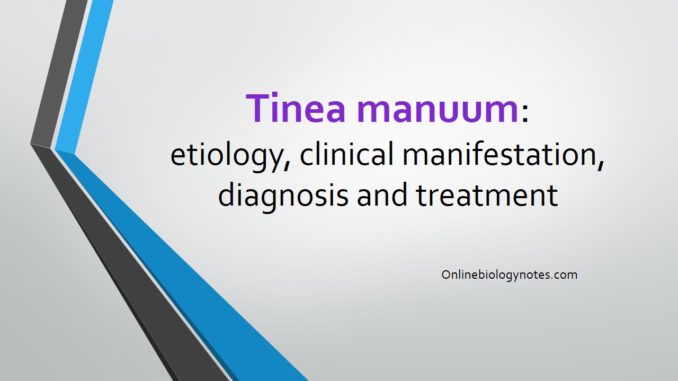
What is Tinea manuum?
- The term tinea manuum refers to dermatophyte infections of one or both hands.
- Tinea refers to ringworm and manuum refers being on hand.
- Geographical distribution:
- It is distributed worldwide.
Epidemiology of tinea manuum:
- Etiology:
- The commonest causes of tinea manuum are anthropophilic dermatophytes Trichophyton rubrum and T. mentagrophytes var. interdigitale.
- Less commonly, the condition is caused by zoophilic dermatophytes, such as Microsporum canis and T. verrucosum, or geophilic dermatophytes, such as M. gypseum.
- Dermatophytosis of the hands can be acquired as a result of contact with another person, an animal or soil, either through direct contact, or via a contaminated object such as a towel or gardening tool.
- Autoinoculation from another site of infection can also take place.
- Manual work, profuse sweating and existing inflammatory conditions, such as contact eczema, are predisposing factors.
Clinical manifestations of tinea manuum:
- Tinea manuum is usually unilateral, the right hand being more commonly affected, and is characterized by a dry scaling eruption of one palm.
- Lesions on the dorsum of the hand or in the interdigital spaces appear similar to those of tinea corporis.
- They have a distinct margin and central clearing may occur.
- Two clinical forms of palmar infection may be distinguished:
- the dyshidrotic or eczematoid form
- the hyperkeratotic form
- It is not un- usual for one form to turn into the other.
- The dyshidrotic or eczematoid form of tinea manuum:
- In this condition, periods of partial remission occurs between successive exacerbations.
- It is characterized in the acute stage by vesicles which tend to appear in an annular or segmental pattern.
- These are localized to the edges of the hand, to the lateral and palmar aspects of the fingers, or to the palm itself where the vesicles are rather larger, tense, often single, and contain a clear viscous fluid.
- Removal ofthe top of the vesicles exposes a pinkish-red weeping surface with fine scaling margins.
- Pruritus, formication and burning are common symptoms.
- The hyperkeratotic form of tinea manuum:
- It is a subacute or chronic condition.
- It begins as a succession ofadjacent vesicles which desquamate.
- This results in a reddened scaling lesion which is round or irregular in outline and enclosed by a thick white squamous margin from which extensions run straight towards the centre.
- Once the chronic stage is reached, the disease involves most or all of the palm and fingers.
- The dry hyperkeratosis, with underlying erythema, readily causes fissuring in the palmar creases.
- The hand has a mealy appearance because of the furfuraceous scales that remain adherent to the horny layer. This is thickened and black in the creases.
Differential diagnosis of tinea manuum:
- Tinea manuum needs to be differentiated from other forms of dyshidrosis.
- This condition is usually bilateral or even symmetrical.
- In its particular form, clear vesicles are placed on the lateral and volar aspects of the fingers as well as on the palm.
- There is little or no inflammation of the base.
- Dyshidrotic eczema is usually bilateral, but mycological examination is frequently required to differentiate it and other conditions (such as psoriasis, whether pustular or not) from tinea manuum.
Lab diagnosis of Tinea manuum:
- Microscopy:
- Direct microscopic examination of infected material, such as vesicle tops and contents and skin scales, should expose the branching hyphae characteristic of a dermatophyte infection.
- Culture:
- Isolation of the aetiological agent in culture will allow the species of fungus engaged to be detected.
Treatment of Tinea manuum:
- Tinea manuum often coexists with tinea pedis.
- Local treatment with a topical imidazole, such as clotrimazole, econazole, miconazole or sulconazole, or an allyllamine, such as naftifine or terbinafine, will often suffice.
- Oral terbinafine (250mg/day for 2-6 weeks), or itraconazole (100mg/day for 4 weeks) should be advised in cases that fail to respond to topical treatment,.
Prevention:
- It is essential to recognize potential sources of infection and, in the case of household pets, take the animal for treatment of suspected dermatophytosis to prevent transmission or recurrence of zoophilic tinea manuum,
- Infection with anthropophilic species, such as T. rubrum, seldom follows transmission from another infected body site, such as the feet, groin or nails.
- These sites should be examined and treated if dermatophytosis is present in order to prevent recurrence.
